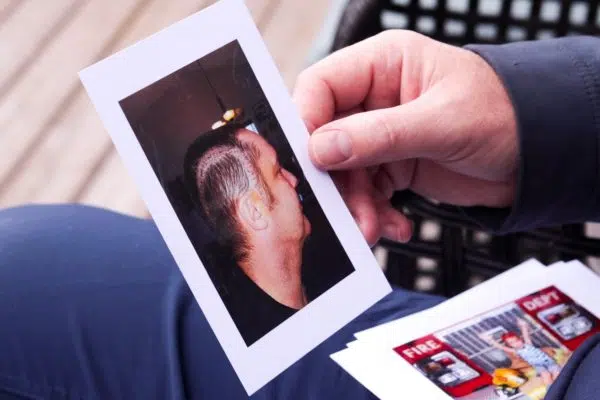
Calgary firefighter and brain cancer survivor Billy Stewart reminiscing about the days after his brain surgery through a photo of him showing the fifty-five titanium staples in his head. (Riggs Zyrille Vergara, CMRU.ca)
Red and yellow lights can be seen flashing from a big red truck. Its siren, loud and consistent, wakes up the neighbourhood. The skies are a mix of black smoke and an orange glow.
The truck doors open and who walk out are men in brown bulky protective wear. Billy Stewart, a man now in his early 50s, comes out of the driver’s door and faces the flying ashes of wood and plastic coming from a huge house fire.
Stewart has been serving Calgary as a firefighter for more than nine years. Through these long years, he has done everything a firefighter must have done.
“Even in one day, you can have a simple call and this is the honest truth, I’ve done this. You can be getting the call to get the cat out of a tree to a full-blown house or garage fire or a major car crash where you have cut somebody out of a car. It can go from one to twenty in a heartbeat,” Stewart said.
On Jan. 9, 2017, after bringing food to his crew to his station, Stewart felt a wave of nausea hit him. This nausea continued while he was driving which made him stop three times on the road. Before leaving the station, he started dry heaving. His crew let him go to the ambulance and there he was, thinking he might be having a stroke.
Little did Stewart know that this is the day that would drastically change the course of his life.
Find out more about Billy Stewart’s life and this life-changing moment in this video:
Luckier than Most
On the same day that Stewart was rushed to the hospital, he was diagnosed with Giant Cell Glioblastoma. It’s a rare subtype of Glioblastoma which is a brain tumour known to be fast-growing and aggressive.
Two weeks after being diagnosed in 2017, Stewart immediately had to undergo brain surgery potentially risking his life under the needle. Fortunately, the surgeon from Foothills Hospital successfully removed 90-95 per cent of the tumour.
Stewart considers himself lucky, surpassing the common survival rates of people diagnosed with his condition.
According to the Brain Tumour Foundation of Canada, the median survival of patients diagnosed with Glioblastoma is 14.6 months. The Brain Tumour Charity also says that only 25 per cent of patients with Glioblastoma survive more than a year and only five per cent survive more than five years.
A week after the surgery, Stewart started having radiation and chemotherapy sessions five days a week for almost two months. After that treatment, Stewart’s doctors recommended that he would have an MRI scan every three to four months to make sure that his brain can stay as healthy as it can be.
More than 3,000 Canadians have been diagnosed with brain cancer in the year 2021 alone, according to the Terry Fox Research Institute.
According to the Sunnybrook Health Sciences Centre, Glioblastoma is “a difficult cancer to treat.” This is because conventional therapies are not that effective in treating this kind of cancer. Its tumour cells are resistant to these therapies and the brain can be susceptible to damage to these same therapies. The brain also has a limited capacity in repairing itself. Another reason the centre had said is that “Many drugs cannot cross the blood-brain barrier to act on the tumour.”
Stewart is also one of the few current survivors of firefighters diagnosed with occupational cancer in Calgary.
Since 1985, Calgary has lost 58 firefighters in the line of duty, 49 of which were from occupational cancer. According to the International Association of Fire Fighters, this is currently the leading cause of line-of-duty deaths for firefighters around the world.
Occupational Cancer in Firefighting
According to CAREX Canada, a team of researchers and specialists who aim to provide organisations with knowledge about Canadians’ exposures to known and suspected carcinogens, firefighters are exposed to hundreds of contaminants while at work.
Some of these carcinogens or cancer-causing chemicals include asbestos, benzene, diesel engine exhaust, ethylbenzene, formaldehyde, polychlorinated biphenyl, polycyclic aromatic hydrocarbons and solar radiation.
Most of these carcinogens can be found in common house fires which can be inhaled by or be in contact with the firefighters while on the job.
To know more about the specific details of occupational cancer within firefighting, follow these links:
- Occupational Cancer in Canadian Firefighters
- Firefighters: Occupational Cancer
- Cancer Incidence and Mortality among Firefighters: An Overview of Epidemiologic Systematic Reviews
- Firefighter Cancer Support Resources
According to Codey McIntyre, the president of the union Calgary Firefighters Association (CFA), one of the many factors that contribute to the high incidence of cancers in firefighting is the high rate of exposure to carcinogens or cancer-causing chemicals because of longer response times.
The longer that firefighters stay inside the house fire or wherever the fire incident may be, the more likely they are exposed to many carcinogens. McIntyre emphasises that the limited number of firefighters contribute to longer response times as the more firefighters there are on the fire incident, the shorter the response time.
Calgary ‘s Situation
When firefighters in Calgary get cancer, the presumptive cancer legislation implemented by Alberta is one of the most helpful resources they can tap into.
Through the legislation, firefighters can receive coverage if they get diagnosed with cancer. Firefighters don’t need to prove that they have contracted it from the job, provided that they have been regularly exposed to fire incidents.
This coverage can include financial assistance for treatment and care and even assistance to the firefighter’s family after the firefighter passes away from cancer.
In a press release from the government of Alberta in 2010, Alberta Firefighters Association’s secretary at the time, Brad Hoekstra, said that, “This coverage gives firefighters peace of mind that their families will be looked after should they succumb to this occupational disease.”
Find out more about the legislation and the many other factors contributing to the rise of occupational cancer within Calgary firefighters in this video:
During the Calgary municipal budget debate, Matt Osborne, the CFA spokesperson, has said that because of the new communities and developments getting built on the outskirts of Calgary, the firefighters are “getting stretched to the breaking point.”
Calgary has recently sworn in new city council officials and one of the first things they were tasked with is deliberating for the 2022 budget.
During these deliberations, Osborne and the union has asked the council to fund $10.5 million to hire 56 new recruits for the department.
The newly elected council had approved the budget last November 2021 which includes the approval of the union’s plea for more funding.
The union is grateful for this new funding. But looking at how much has been cut from the department from the last few years, only time can tell how helpful this new funding will be.
Author’s Reflection:
Getting to work with Billy Stewart and sharing his story was such a privilege. He was such an open and kind person who is so brave for being vulnerable and sharing a personal part of his life. It opened a new perspective for me at how much more difficult it is to be a firefighter and how committed these people are in helping the public. I hope that through this story, people, especially important decision makers, can appreciate how much value and genuine love these firefighters have for their city.
I was also grateful working with Codey McIntyre and Greg Peter, two firefighters heavily invested in making sure that the Calgary firefighter’s welfare and safety are always prioritised. During the process of creating this story, they were kind and welcoming to someone like me, who was an entirely new person digging deep about their lives. Working with them and Billy made me realise how much more there is to firefighting. It’s not just all about athletic and intellectual ability; having the heart to serve the people, even with so much risk, is what makes their jobs truly special and valuable.



Comments